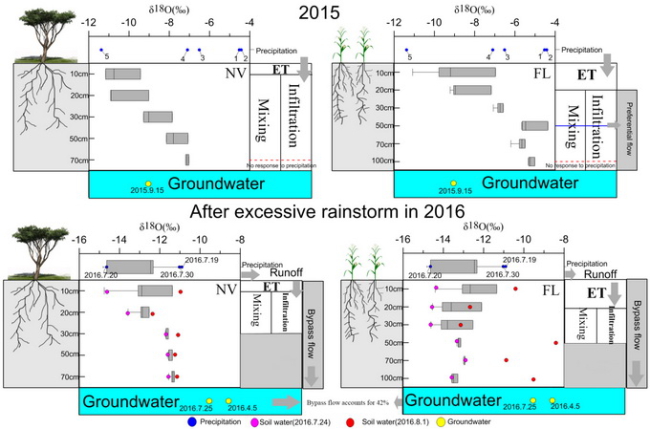
A research team led by Prof. WANG Shiqin, from the
While different pools of soil water (including bound and mobile water) are observed, the mechanisms of soil water movement in semi-arid and sub-humid regions are not well understood due to high variation in soil water storage conditions.
The Taihang Mountain is a headwater region that recharges both groundwater and surface water systems of the North China Plain, where groundwater levels have been declining and water storage loss is serious. Although extreme precipitation is critical for groundwater recharge in headwater regions, the response mechanism of soil water movement and groundwater recharge remains unclear.
In this study, soil water movement and groundwater recharge mechanisms in a cultivated farmland (FL) and land under natural vegetation (NV) were determined for a normal and an extreme precipitation year through the combined use of soil water content and stable isotopes of water (δ18O and δ2H).
Heavy precipitation events were the major recharge resources for groundwater due to the activation of preferential flow paths in wet years, while soil water mainly moved downward in the mode of translatory flow during normal wetness conditions.
However, soil water movement mechanism and groundwater recharge appeared to change due to influences of cultivated land and extreme precipitation. Land cultivation and root penetration resulted in preferential flow down to 50cm soil depth under farmland conditions.
During extreme precipitation, the deep (50–100cm) soil layers were quickly filled by the first rainstorm and preferential flow dominated the subsurface flow. Recharged by the first excessive storm, subsequent rains developed bypass flow which produced stream water and groundwater recharge.
Their findings about the observed temporal variability of subsurface flow processes (translatory vs. bypass flow) and the differences between natural and cultivated land could help to better understand groundwater recharge in semi-arid and sub-humid climates.
This work was supported by the Program of National Natural Science Foundation of China, the National Key R&D Program of China, and the Program of National Natural Science Foundation of Hebei Province.

Conceptual model for soil water movement under natural vegetation (NV) and farmland (FL) conditions in normal year (2015) and wet year (2016) after excessive rainstorm. (Image by WANG Shiqin's team)

86-10-68597521 (day)
86-10-68597289 (night)

52 Sanlihe Rd., Xicheng District,
Beijing, China (100864)

